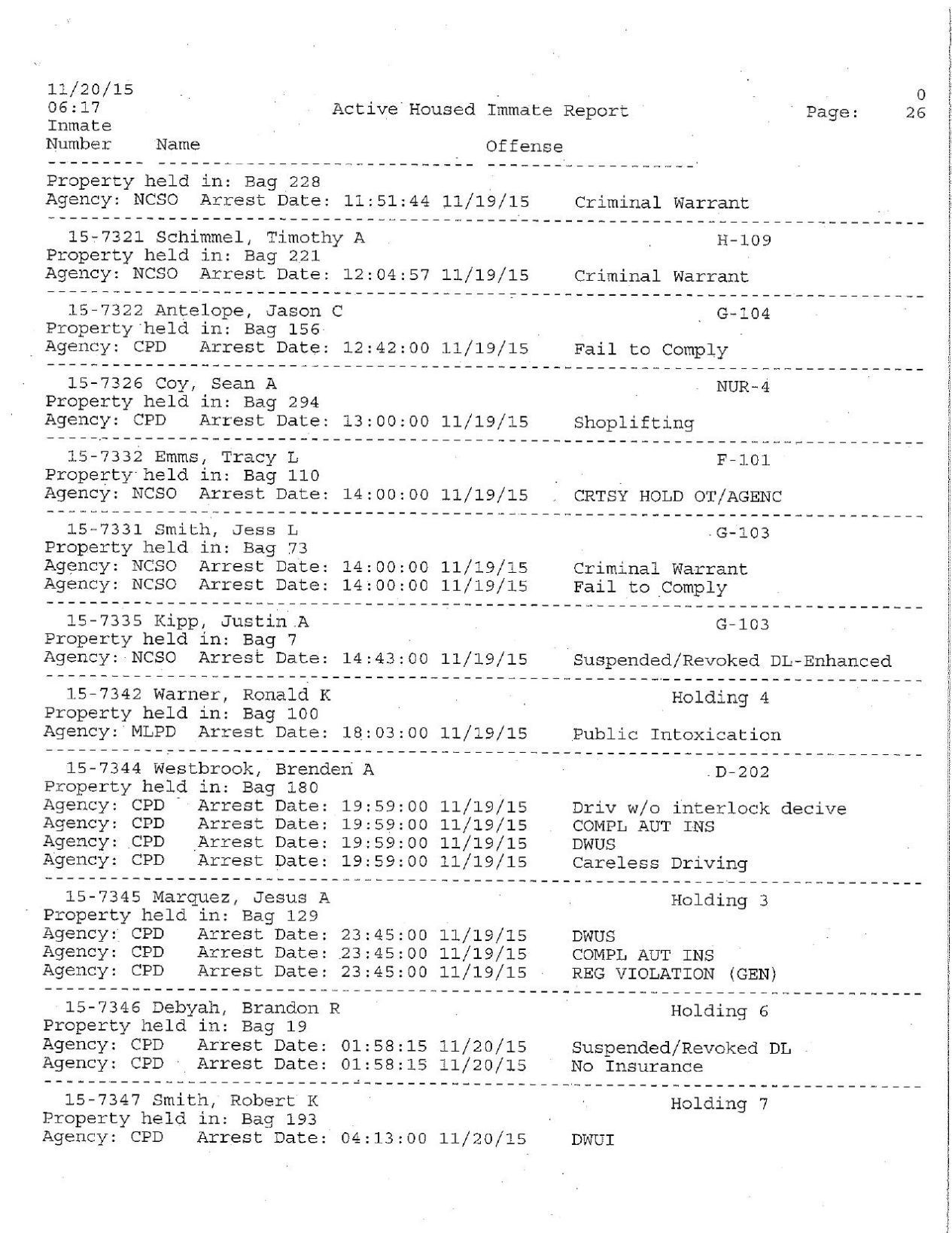Cross Country Inmate Roster List: A Comprehensive Guide To Understanding The System
Let’s face it, folks. The topic of cross country inmate roster lists might not be the most cheerful conversation starter, but it’s a crucial aspect of our justice system that deserves attention. Whether you’re researching for personal reasons, working in law enforcement, or simply curious about how these systems work, understanding inmate rosters across states is more important than ever. In this article, we’ll break it down for you—what it is, why it matters, and how it impacts society.
You might be wondering, "What exactly is a cross country inmate roster list?" Simply put, it’s a compilation of data that tracks inmates who are housed in correctional facilities nationwide. This information can include names, booking numbers, charges, and even mugshots. It’s not just a random database—it plays a significant role in maintaining transparency and accountability in our criminal justice system. Stick with me, because we’re about to dive deep into the nitty-gritty details.
Now, here’s the thing. This isn’t just some random list sitting on a server somewhere. These rosters are updated regularly, and they’re accessible to certain individuals or entities, depending on the state’s laws. From law enforcement agencies to family members seeking information about loved ones, these lists serve a variety of purposes. So, buckle up, because we’re going to explore everything you need to know about cross country inmate roster lists.
Read also:Reliving The Iconic Style And Friendships Of The Friends Cast
Why Cross Country Inmate Roster Lists Matter
Alright, let’s talk about why these lists are such a big deal. First off, they provide a level of transparency that’s essential in our justice system. By keeping track of inmates across different states, authorities can ensure that criminals don’t slip through the cracks. For example, if someone is transferred from one state to another, their information is documented and accessible to the relevant authorities. It’s like having a nationwide database that keeps everyone in the loop.
But it’s not just about law enforcement. Families and friends of inmates can also benefit from these lists. Imagine trying to locate a loved one who’s been moved to a different facility without any information. It would be a nightmare, right? These rosters make it easier for people to stay connected, even when circumstances are less than ideal. Plus, they give a sense of closure and reassurance to those who are searching for answers.
How These Lists Are Compiled
So, how exactly do these cross country inmate roster lists come together? It’s a bit of a complex process, but I’ll try to simplify it for you. Each state has its own database of inmates, which includes information like names, IDs, charges, and facility locations. These databases are then linked together through a national network, allowing for seamless communication between states. Think of it like a giant puzzle where all the pieces fit together perfectly—or at least, they’re supposed to.
Now, here’s the kicker. Not all states share their data equally. Some are more open about their inmate information, while others keep things under wraps. This can create challenges when trying to access certain records, especially if you’re not familiar with the system. But don’t worry—we’ll get into that a bit later.
Accessing Cross Country Inmate Roster Lists
Let’s say you want to access one of these lists. Where do you start? Well, it depends on who you are and what your intentions are. If you’re part of law enforcement, you probably already have the necessary clearance to view these records. But if you’re a concerned citizen or family member, the process might be a bit more complicated.
Most states offer online portals where you can search for inmate information. These portals usually require you to enter basic details like the person’s name or booking number. Some even let you filter results by location or charge type. It’s like doing a Google search, but with a lot more rules and restrictions. And let’s be real—navigating these systems can be a bit tricky if you’re not familiar with them.
Read also:Dolly Partons Secret Tattoos A Conversational Dive Into Her Artful Choices
Challenges in Accessing Data
While these online portals are convenient, they’re not without their flaws. For starters, not all states have the same level of accessibility. Some might require you to visit a physical location to view certain records, while others might charge fees for accessing detailed information. It’s like trying to unlock a hidden level in a video game—sometimes it just feels impossible.
Another challenge is accuracy. Mistakes can happen, and when they do, it can lead to confusion or misinformation. For example, if someone has a common name, you might end up finding the wrong person’s record. Or worse, you might not find anything at all. That’s why it’s important to double-check your information and make sure you’re looking in the right places.
Understanding the Legal Framework
Before we go any further, let’s talk about the legal side of things. Each state has its own laws regarding inmate data and how it can be accessed. Some states have strict privacy policies that limit who can view certain records, while others are more lenient. It’s like a patchwork quilt of regulations that can vary wildly depending on where you are.
For example, in California, certain inmate information is considered public record and can be accessed by anyone. But in other states, like Texas, you might need a court order to view specific details. It’s all about striking a balance between transparency and privacy, which isn’t always easy to achieve.
Privacy Concerns and Ethical Considerations
Now, let’s address the elephant in the room—privacy. Some people argue that making inmate information publicly available is a violation of their rights. After all, everyone deserves a second chance, right? On the other hand, others believe that transparency is key to maintaining accountability in the justice system. It’s a delicate issue that doesn’t have a clear-cut answer.
Then there’s the ethical side of things. How do we ensure that this information is used responsibly? What happens if someone misuses these lists for malicious purposes? These are questions that need to be addressed as we continue to develop and refine these systems. It’s not just about collecting data—it’s about using it wisely.
Benefits of Cross Country Inmate Roster Lists
Despite the challenges, there are plenty of benefits to having a nationwide inmate roster system. For starters, it helps law enforcement agencies track criminals more efficiently. If someone is wanted in one state but hiding out in another, these lists make it easier to locate them. It’s like having a GPS for criminals, except instead of finding the nearest coffee shop, you’re finding people who’ve broken the law.
Additionally, these lists can help prevent overcrowding in prisons. By keeping track of inmate movements and transfers, authorities can better manage resources and ensure that facilities aren’t over capacity. It’s like playing Tetris with people’s lives, but with a much more serious purpose.
Impact on Families and Communities
Let’s not forget the human side of things. For families and communities affected by crime, these lists can provide a sense of security and closure. Knowing where a loved one is or where a dangerous individual is being held can make a huge difference in someone’s life. It’s about giving people the information they need to make informed decisions.
But it’s not just about the families. These lists also have a broader impact on society as a whole. By promoting transparency and accountability, they help build trust between the public and the justice system. It’s like saying, "Hey, we’re not hiding anything here. Everything’s out in the open."
Common Misconceptions
There are a lot of myths and misconceptions surrounding cross country inmate roster lists. Some people think that these lists are only accessible to law enforcement, while others believe that they contain every single detail about an inmate’s life. The truth is, it’s somewhere in between.
For instance, not all states allow public access to these lists, and even when they do, the information is often limited. You won’t find things like medical records or personal correspondence in these databases. It’s all about striking a balance between providing useful information and respecting people’s privacy.
Separating Fact from Fiction
So, how do you separate fact from fiction when it comes to these lists? The best way is to do your research. Look for reputable sources and don’t believe everything you read online. Just because someone says something is true doesn’t mean it actually is. It’s like that old saying—trust, but verify.
Another tip is to ask questions. If you’re unsure about something, don’t hesitate to reach out to the appropriate authorities or organizations for clarification. They’re usually more than happy to help, especially if it means promoting transparency and understanding.
Future Developments
As technology continues to evolve, so too will the way we manage and access cross country inmate roster lists. We’re already seeing advancements in areas like AI and data analytics that could revolutionize the way these systems work. Imagine being able to predict inmate behavior or identify patterns in criminal activity before they even happen. It’s like having a crystal ball for law enforcement.
But with these advancements come new challenges. How do we ensure that these technologies are used ethically and responsibly? What happens if someone hacks into these systems and steals sensitive information? These are questions that need to be answered as we move forward into the future.
Potential Innovations
One potential innovation is the use of blockchain technology to secure inmate data. By creating a decentralized database that’s nearly impossible to hack, we could significantly reduce the risk of data breaches. It’s like putting a digital lock on these lists that only authorized individuals can open.
Another possibility is the integration of facial recognition software to improve accuracy and efficiency. Imagine being able to identify an inmate simply by scanning their face. It’s like something out of a sci-fi movie, but it could become a reality sooner than you think.
Conclusion
Well, folks, that’s a wrap on our deep dive into cross country inmate roster lists. From understanding what they are to exploring the legal, ethical, and technological aspects, we’ve covered a lot of ground. These lists might not be the most glamorous topic, but they play a vital role in our justice system and society as a whole.
Remember, whether you’re a concerned citizen, a family member, or someone working in law enforcement, these lists are here to help. They provide transparency, accountability, and a sense of security that’s hard to come by in today’s world. So, if you ever find yourself needing to access one of these lists, don’t hesitate to do your research and ask questions.
And finally, I’d love to hear your thoughts on this topic. Do you think these lists strike the right balance between transparency and privacy? Or do you believe there’s more work to be done? Leave a comment below, share this article with your friends, or check out some of our other posts for more insights into the world of criminal justice. Thanks for reading, and stay curious!
Table of Contents
- Why Cross Country Inmate Roster Lists Matter
- How These Lists Are Compiled
- Accessing Cross Country Inmate Roster Lists
- Challenges in Accessing Data
- Understanding the Legal Framework
- Privacy Concerns and Ethical Considerations
- Benefits of Cross Country Inmate Roster Lists
- Impact on Families and Communities
- Common Misconceptions
- Separating Fact from Fiction
- Future Developments
- Potential Innovations
Article Recommendations


